
Christmas Cracker X-Ray Dosimeter
Proud Mary, Wed Dec 15 2010, 04:26PMUNDER CONSTRUCTION
Christmas Cracker X-Ray Dosimeter
Here's an easy little project I've invented for folk needing to monitor the output of X-ray sources down to about 15keV.
It will be of no use at all for detecting μGy levels of radiation from smoke detectors, gas mantles, uranium marbles, lumps of
uraninite, and so on.
I've tried to photograph every step in the construction to help 4HV members for whom English is not a first language.

The dosimeter is based around a light dependent resistor called NORPS-12 and a small piece of Fuji G-6 front-side terbium-doped gadolinium oxysulphide X-ray intensifying screen.
In this design, we use both the light emitted by the intensifying screen to reduce the resistance of the LDR, and the direct effect of the X-rays on the CdS to give a much more sensitive device than could have been obtained with the LDR alone.
NORPS-12 is the Silonex version of the well-known Mullard ORP12. Here is the data sheet:
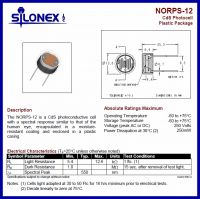
I had no idea that light dependent resistors - LDRs - could serve as X-ray dosimeters until I came across a small locked box in the cellar, in which I found
certain old deeds and papers, one of them talking about X-ray sensitive LDRs.
What struck me first was the very wide dynamic range of these vintage LDRs, housed as they were in glass envelopes like thermionic valves. Some had a dark resistance of 10MΩ, falling to less than 100Ω in bright light.
In contrast, the Silonex NORPS-12 data sheet gives a dark resistance of 1MΩ min.
I thought I'd better find out what 1MΩ 'minimum' was likely to mean in practice. I took ten NORPS-12, and tested each one inside a sealed black box. All ten of them had a dark resistance greater than 200MΩ, the maximum reading on my bench DVM.
When I tried to test them above 200MΩ on my Takeda Riken High Megohm Meter, which has switched test voltage options, I discovered significant voltage dependent resistance, which has to be taken into account when using LDRs for measurements.

I decided to use a steel punch and a lump hammer to cut out neat circles from a scrap of intensifying screen.
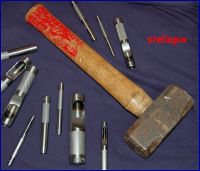
A 12mm punch turns out to be just the right size for the 'shoulders' of the LDR housing.
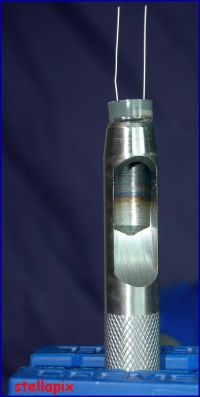
Even a good wallop with the hammer didn't cut all the way through the screen. But it did cause the sensitive top surface to delaminate from the tough black plastic backing, which I thought all to the good. Now there would be less material to absorb X-rays on their way through the screen and into the CdS layer in the sensor.
The screen I used was Fuji G-6, but other screens may not delaminate in this way. If you cut through your screen with curved nail scissors, scalpel, or craft knife rather than using a punch as I have done, then delamination is less likely. Anyway, it's not important at all, and will make very very little difference to the rays shining through it.
I have specified front-side intensifying screen for this project, since the rays must pass right through it, whereas back screens usually contain an X-ray blocking layer to attenuate rays passing right through the cassette.

A small drop of cyanoacrylate 'super glue' is squeezed onto the face of the LDR, and the intensifying screen disk dropped onto it with tweezers. Make sure the
glossy cream coloured surface of the screen is facing down!
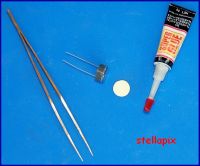

Here I have first secured a small piece of kitchen aluminium foil to the top of the screen with a drop of glue, and then wrapped it round the sides. I secured the aluminium with self-adhesive copper strip so that an electrical connection could be made to it if Faraday screening was found necessary.
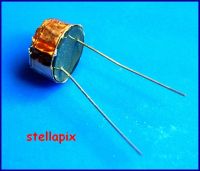
I was surprised to find that with the top and sides made completely opaque to visible light by the metal foils, that sufficient light was still able to penetrate the base underside to reduce the resistance of the device from >200MΩ to about 40kΩ.
This discovery made me realize that the device was much more sensitive than I had imagined - and that measurement down to the low cGy level might be possible.
Coming Next: The 100V stabilized voltage source
UNDER CONSTRUCTION
Re: Christmas Cracker X-Ray Dosimeter
Nicko, Wed Dec 15 2010, 05:42PM
Fantastic stuff.
Small side note:
DO NOT TRY THE FOLLOWING:
When I was at boarding school as a young and very dangerous lad, I came up with a novel scheme using ORP12s to scare the bits out of friends...
In the DARK, I wired an ORP12 across mains live & neutral inside a plug, with the face of the LDR by the wire entrance of the plug...
The poor unsuspecting victim would then walk into their room, turn on the light, at which point there would be an enormous explosion from under their bed as the LDR dropped from megohms to just a few ohms, and detonated.
In retrospect, very stupid, as Cadmium sulphide is not nice stuff, but then again, nor is flying glass.
But very satisfying.
We moved on from that to detonating tubes of "Signal" toothpaste - you could paint the whole of someone's study in red & write stripes in a fraction of a second (with added bonus of the minty aroma)...
Ahhhh. The innocence of youth.
Sorry for the thread hijack - feel free to delete this post should you wish!
On a slightly more relevant note - as you used adhesive Cu foil to fix the Al screen, did the Cu make good electrical contract with the Al bearing in mind the film of adhesive?
Cheers
Nicko, Wed Dec 15 2010, 05:42PM
Fantastic stuff.
Small side note:
DO NOT TRY THE FOLLOWING:
When I was at boarding school as a young and very dangerous lad, I came up with a novel scheme using ORP12s to scare the bits out of friends...
In the DARK, I wired an ORP12 across mains live & neutral inside a plug, with the face of the LDR by the wire entrance of the plug...
The poor unsuspecting victim would then walk into their room, turn on the light, at which point there would be an enormous explosion from under their bed as the LDR dropped from megohms to just a few ohms, and detonated.
In retrospect, very stupid, as Cadmium sulphide is not nice stuff, but then again, nor is flying glass.
But very satisfying.
We moved on from that to detonating tubes of "Signal" toothpaste - you could paint the whole of someone's study in red & write stripes in a fraction of a second (with added bonus of the minty aroma)...
Ahhhh. The innocence of youth.
Sorry for the thread hijack - feel free to delete this post should you wish!
On a slightly more relevant note - as you used adhesive Cu foil to fix the Al screen, did the Cu make good electrical contract with the Al bearing in mind the film of adhesive?
Cheers
Re: Christmas Cracker X-Ray Dosimeter
Sulaiman, Wed Dec 15 2010, 07:26PM
I have no experience of the intensifying screens
but I've had a ZnS 'spinthariscope' screen for quite a while
(exactly like the current eBay item# 220705434744 same seller)
and a smoke detector Americium source.
This type of screen seems very sensitive,
from occasional random flashes (over 10mm if memory serves)
to a bright (after you are dark adapted) solid fog when closest.
Can the intensifier screens be used for a spinthariscope with Am ?
Sulaiman, Wed Dec 15 2010, 07:26PM
I have no experience of the intensifying screens
but I've had a ZnS 'spinthariscope' screen for quite a while
(exactly like the current eBay item# 220705434744 same seller)
and a smoke detector Americium source.
This type of screen seems very sensitive,
from occasional random flashes (over 10mm if memory serves)
to a bright (after you are dark adapted) solid fog when closest.
Can the intensifier screens be used for a spinthariscope with Am ?
Re: Christmas Cracker X-Ray Dosimeter
radhoo, Wed Dec 15 2010, 07:39PM
Proud Mary,
This is excellent! I never thought of using CdS photo-resistors together with intensifying screens for this purpose:
Time to put these two together -and-
-and- 
Thanks!
radhoo, Wed Dec 15 2010, 07:39PM
Proud Mary,
This is excellent! I never thought of using CdS photo-resistors together with intensifying screens for this purpose:
Time to put these two together
 -and-
-and- 
Thanks!
Re: Christmas Cracker X-Ray Dosimeter
Proud Mary, Wed Dec 15 2010, 08:47PM
I would expect fluorescence with such energetic particles as americium alphas, if they are able to penetrate any surface skin or polymer matrix containing the Gd2O2S:Tb3 . But I've not tried it, so I can't say yay or nay, and am probably the only person here whose Am source is still stuck to the ceiling in the burnt toast detector.
Unlike a ZnS spinthariscope screen, X-ray intensifying screens are not transparent at optical wavelengths. Even with the accidentally discovered delamination I describe above, the sensitive layer will not be able to transmit tiny flashes, though a great myriad of them might suffuse it with a general glow. Viewing would have to be done from the same side as the source, though this shouldn't be too hard to arrange.
My knowledge of CdS LDRs is still at a very basic level, but this is improving as I work my way through the literature.
One feature that might be relevant to LDR response to single particles is that of time delay. After the sensor has been exposed to bright light, it takes as much as half an hour in complete darkness for the full >200MΩ dark resistance to return.
Another peculiarity described in the literature is that of pre-loading with blue light. If the LDR is exposed to an initial dose of blue light, its sensitivity is said to increase ten times. A similar phenomenon is found in phosphate glass thermoluminescent dosimeters - TLDs -, some of which have to be pre-charged with UV before they can be used for gamma dosimetry. It's all about electrons trapped in conduction bands, but I don't understand it well enough to explain it to others at this stage.
In the case of X-rays, I am expecting the maximum sensitivity of my device to be somewhere in the low cGy - somewhere between 100 and 1000 times greater than the gamma dose close up to the very best pitchblende.
A typical dental tube running at 70kV/3mA will produce a dose-rate of very roughly 1Sv/minute at a distance of 30cm - say 10,000 times more than the hottest of pitchblende can provide to a detector placed in contact with the sample, and perhaps a million times more than the pitchblende would be able to produce at an equal range of 30cm. This, I feel, puts it into perspective.
What's the betting Plazamatron has tried to scintillate with intensifying screen and an Am alpha source? Some while ago he coupled an intensifying screen to an image intensifier in a kind of fluoroscope, and I'm sure he must have tried it with an Am or other alpha source.
Proud Mary, Wed Dec 15 2010, 08:47PM
Sulaiman wrote ...
I have no experience of the intensifying screens
but I've had a ZnS 'spintariscope' screen for quite a while
(exactly like the current eBay item# 220705434744 same seller)
and a smoke detector Americium source.
This type of screen seems very sensitive,
from occasional random flashes (over 10mm if memory serves)
to a bright (after you are dark adapted) solid fog when closest.
Can the intensifier screens be used for a spinthariscope with Am ?
I have no experience of the intensifying screens
but I've had a ZnS 'spintariscope' screen for quite a while
(exactly like the current eBay item# 220705434744 same seller)
and a smoke detector Americium source.
This type of screen seems very sensitive,
from occasional random flashes (over 10mm if memory serves)
to a bright (after you are dark adapted) solid fog when closest.
Can the intensifier screens be used for a spinthariscope with Am ?
I would expect fluorescence with such energetic particles as americium alphas, if they are able to penetrate any surface skin or polymer matrix containing the Gd2O2S:Tb3 . But I've not tried it, so I can't say yay or nay, and am probably the only person here whose Am source is still stuck to the ceiling in the burnt toast detector.
Unlike a ZnS spinthariscope screen, X-ray intensifying screens are not transparent at optical wavelengths. Even with the accidentally discovered delamination I describe above, the sensitive layer will not be able to transmit tiny flashes, though a great myriad of them might suffuse it with a general glow. Viewing would have to be done from the same side as the source, though this shouldn't be too hard to arrange.
My knowledge of CdS LDRs is still at a very basic level, but this is improving as I work my way through the literature.
One feature that might be relevant to LDR response to single particles is that of time delay. After the sensor has been exposed to bright light, it takes as much as half an hour in complete darkness for the full >200MΩ dark resistance to return.
Another peculiarity described in the literature is that of pre-loading with blue light. If the LDR is exposed to an initial dose of blue light, its sensitivity is said to increase ten times. A similar phenomenon is found in phosphate glass thermoluminescent dosimeters - TLDs -, some of which have to be pre-charged with UV before they can be used for gamma dosimetry. It's all about electrons trapped in conduction bands, but I don't understand it well enough to explain it to others at this stage.
In the case of X-rays, I am expecting the maximum sensitivity of my device to be somewhere in the low cGy - somewhere between 100 and 1000 times greater than the gamma dose close up to the very best pitchblende.
A typical dental tube running at 70kV/3mA will produce a dose-rate of very roughly 1Sv/minute at a distance of 30cm - say 10,000 times more than the hottest of pitchblende can provide to a detector placed in contact with the sample, and perhaps a million times more than the pitchblende would be able to produce at an equal range of 30cm. This, I feel, puts it into perspective.
What's the betting Plazamatron has tried to scintillate with intensifying screen and an Am alpha source? Some while ago he coupled an intensifying screen to an image intensifier in a kind of fluoroscope, and I'm sure he must have tried it with an Am or other alpha source.
Re: Christmas Cracker X-Ray Dosimeter
Wolfram, Wed Dec 15 2010, 09:09PM
I've tried it with a bit of x-ray intensifying screen, and a three-stage 1st generation image intensifier and a smoke detector alpha source, and I can confirm that it works. I haven't tried it without the image intensifier, but I think there's a good chance that it would work. I don't know whether it's the alphas or the gammas that make the intensifying screen scintillate, but I guess it's the gammas, as alphas would most likely not pass through the back of the intensifying screen.
Very interesting thread by the way, I'm interested in trying this out myself. What about photodiodes or phototransistors? They don't have the pesky memory effect that LDRs have, but do they have large enough dynamic range?
Anders M.
Wolfram, Wed Dec 15 2010, 09:09PM
Proud Mary wrote ...
What's the betting Plazamatron has tried to scintillate with intensifying screen and an Am alpha source? Some while ago he coupled an intensifying screen to an image intensifier in a kind of fluoroscope, and I'm sure he must have tried it with an Am or other alpha source.
What's the betting Plazamatron has tried to scintillate with intensifying screen and an Am alpha source? Some while ago he coupled an intensifying screen to an image intensifier in a kind of fluoroscope, and I'm sure he must have tried it with an Am or other alpha source.
I've tried it with a bit of x-ray intensifying screen, and a three-stage 1st generation image intensifier and a smoke detector alpha source, and I can confirm that it works. I haven't tried it without the image intensifier, but I think there's a good chance that it would work. I don't know whether it's the alphas or the gammas that make the intensifying screen scintillate, but I guess it's the gammas, as alphas would most likely not pass through the back of the intensifying screen.
Very interesting thread by the way, I'm interested in trying this out myself. What about photodiodes or phototransistors? They don't have the pesky memory effect that LDRs have, but do they have large enough dynamic range?
Anders M.
Re: Christmas Cracker X-Ray Dosimeter
Proud Mary, Wed Dec 15 2010, 09:42PM
PIN photodiodes are very widely used in gamma ray photon counters and dosimeters, as I've often noted in this forum. Even PIN photodiodes not originally designed as gamma detectors such as BPX65 have been used in professional dosimetry systems. BPX65 was on the very edge of extinction, but Centronic now have it in their current catalogue. The quantum efficiency of bare PIN photodiodes is very roughly 99% at 1.5keV, and 1% at 100keV.
Even a series string of half a dozen reverse biased 1N4007s will draw some current in an X-ray beam. There are even chemical dosimeters for lovers of obscure knowledge.
But my purpose in devising the Christmas Cracker Dosimeter was to provide a very simple yet good design that would be accessible to all at a low price. With the help of a simple 100V constant voltage source, no more than an ordinary multimeter is required to make comparative X-ray measurements with this device.
Further on in the thread, we will look at the relative contribution made by the screen's emitted light, and the CdS's direct X-ray detection, and how this relates to the linearity of the dose/resistance graph.
Proud Mary, Wed Dec 15 2010, 09:42PM
Anders M. wrote ...
Very interesting thread by the way, I'm interested in trying this out myself. What about photodiodes or phototransistors? They don't have the pesky memory effect that LDRs have, but do they have large enough dynamic range?
Very interesting thread by the way, I'm interested in trying this out myself. What about photodiodes or phototransistors? They don't have the pesky memory effect that LDRs have, but do they have large enough dynamic range?
PIN photodiodes are very widely used in gamma ray photon counters and dosimeters, as I've often noted in this forum. Even PIN photodiodes not originally designed as gamma detectors such as BPX65 have been used in professional dosimetry systems. BPX65 was on the very edge of extinction, but Centronic now have it in their current catalogue. The quantum efficiency of bare PIN photodiodes is very roughly 99% at 1.5keV, and 1% at 100keV.
Even a series string of half a dozen reverse biased 1N4007s will draw some current in an X-ray beam. There are even chemical dosimeters for lovers of obscure knowledge.
But my purpose in devising the Christmas Cracker Dosimeter was to provide a very simple yet good design that would be accessible to all at a low price. With the help of a simple 100V constant voltage source, no more than an ordinary multimeter is required to make comparative X-ray measurements with this device.
Further on in the thread, we will look at the relative contribution made by the screen's emitted light, and the CdS's direct X-ray detection, and how this relates to the linearity of the dose/resistance graph.

Re: Christmas Cracker X-Ray Dosimeter
Freitsu, Thu Dec 16 2010, 07:57AM
Great writeup, Proud Mary!
This is one thread that deserves bookmarking.
Freitsu, Thu Dec 16 2010, 07:57AM
Great writeup, Proud Mary!
This is one thread that deserves bookmarking.

Re: Christmas Cracker X-Ray Dosimeter
Proud Mary, Sun Dec 19 2010, 10:59AM
Readers of this thread will almost certainly enjoy thinking about X-ray detection using solar cells.
When this paper was written, nearly half a century ago, solar cells were in their infancy. Imagine the increase of both sensitivity and surface area that has happened in solar cell technology in that time.
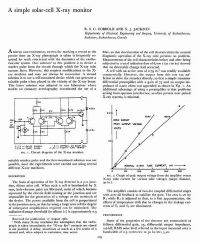
As with the CdS photoconductive cell, covering a silicon solar cell with an X-ray intensifying screen, - or other X-ray scintillator - will enable both direct detection by the cell itself, and indirect detection by collection of light photons emitted by a scintillator.
Proud Mary, Sun Dec 19 2010, 10:59AM
Readers of this thread will almost certainly enjoy thinking about X-ray detection using solar cells.
When this paper was written, nearly half a century ago, solar cells were in their infancy. Imagine the increase of both sensitivity and surface area that has happened in solar cell technology in that time.

As with the CdS photoconductive cell, covering a silicon solar cell with an X-ray intensifying screen, - or other X-ray scintillator - will enable both direct detection by the cell itself, and indirect detection by collection of light photons emitted by a scintillator.
Re: Christmas Cracker X-Ray Dosimeter
Bjørn, Sun Dec 19 2010, 12:57PM
 have a dynamic range of more than a million to one and the response is linear.
have a dynamic range of more than a million to one and the response is linear.
Bjørn, Sun Dec 19 2010, 12:57PM
I don't know whether it's the alphas or the gammas that make the intensifying screen scintillate, but I guess it's the gammas, as alphas would most likely not pass through the back of the intensifying screen.I seem to get 3 classes of radiotion that is halved in intensity by 5 um, 5 mm and 50 mm aluminium. The 5 um type excites phosphor from a fluorecent lamp, the others don't. Probably an idea to come up with a sensible way of detecting the exact type.
Very interesting thread by the way, I'm interested in trying this out myself. What about photodiodes or phototransistors? They don't have the pesky memory effect that LDRs have, but do they have large enough dynamic range?Sensors like
 have a dynamic range of more than a million to one and the response is linear.
have a dynamic range of more than a million to one and the response is linear. Re: Christmas Cracker X-Ray Dosimeter
Proud Mary, Sun Dec 19 2010, 01:30PM
TSL230 looks as though it could be very interesting to try out as an indirect detector with a scintillator, and perhaps as a direct detector too, at an affordable price.
Proud Mary, Sun Dec 19 2010, 01:30PM
Bjørn wrote ...
Sensors like have a dynamic range of more than a million to one and the response is linear.
have a dynamic range of more than a million to one and the response is linear.
Sensors like
 have a dynamic range of more than a million to one and the response is linear.
have a dynamic range of more than a million to one and the response is linear. TSL230 looks as though it could be very interesting to try out as an indirect detector with a scintillator, and perhaps as a direct detector too, at an affordable price.
Re: Christmas Cracker X-Ray Dosimeter
Conundrum, Sun Dec 19 2010, 01:54PM
amazingly cool idea Proud Mary, i will try this asap.
A little "gotcha", superglue sets by absorbing moisture so once the setup is complete its worth carefully drying it in an oven at 50C or so before final encapsulation to ensure that the sensor doesen't fail over time (don't ask how i found that out!!!)
An idea for a small voltage source, get one of those HV825 EL inverter IC's and connect the outputs to a multiplier.
They draw very low current and can be set up to only turn on when the stored voltage begins to drop.
I might have tried this but ran out of IC's due to flaky EL wire.
Another idea is to use a very low power negative resistance oscillator such as the J310+BC212 or 2N3819+PN3820 etc,
these can draw next to no current yet the resonant circuit peak to peak voltage can exceed 200V.
As for lightproof end windows, carefully split and sanded down pyrolytic graphite works (confirmed with CMOS sensor)
and not too expensive at around £9 for enough to make a couple dozen devices.
-A
Conundrum, Sun Dec 19 2010, 01:54PM
amazingly cool idea Proud Mary, i will try this asap.
A little "gotcha", superglue sets by absorbing moisture so once the setup is complete its worth carefully drying it in an oven at 50C or so before final encapsulation to ensure that the sensor doesen't fail over time (don't ask how i found that out!!!)
An idea for a small voltage source, get one of those HV825 EL inverter IC's and connect the outputs to a multiplier.
They draw very low current and can be set up to only turn on when the stored voltage begins to drop.
I might have tried this but ran out of IC's due to flaky EL wire.
Another idea is to use a very low power negative resistance oscillator such as the J310+BC212 or 2N3819+PN3820 etc,
these can draw next to no current yet the resonant circuit peak to peak voltage can exceed 200V.
As for lightproof end windows, carefully split and sanded down pyrolytic graphite works (confirmed with CMOS sensor)
and not too expensive at around £9 for enough to make a couple dozen devices.
-A
Re: Christmas Cracker X-Ray Dosimeter
Proud Mary, Sun Dec 19 2010, 02:36PM
I think as long as folk don't expect these simple devices to work at the µGy level of background counting and small test sources and understand that we're talking of X-ray concentration - photon fluence - of perhaps 10E11 photons/cm2/sec no one will be dissapointed.
Proud Mary, Sun Dec 19 2010, 02:36PM
Conundrum wrote ...
amazingly cool idea Proud Mary, i will try this asap.
A little "gotcha", superglue sets by absorbing moisture so once the setup is complete its worth carefully drying it in an oven at 50C or so before final encapsulation to ensure that the sensor doesen't fail over time (don't ask how i found that out!!!)
An idea for a small voltage source, get one of those HV825 EL inverter IC's and connect the outputs to a multiplier.
They draw very low current and can be set up to only turn on when the stored voltage begins to drop.
I might have tried this but ran out of IC's due to flaky EL wire.
Another idea is to use a very low power negative resistance oscillator such as the J310+BC212 or 2N3819+PN3820 etc,
these can draw next to no current yet the resonant circuit peak to peak voltage can exceed 200V.
As for lightproof end windows, carefully split and sanded down pyrolytic graphite works (confirmed with CMOS sensor)
and not too expensive at around £9 for enough to make a couple dozen devices.
-A
amazingly cool idea Proud Mary, i will try this asap.
A little "gotcha", superglue sets by absorbing moisture so once the setup is complete its worth carefully drying it in an oven at 50C or so before final encapsulation to ensure that the sensor doesen't fail over time (don't ask how i found that out!!!)
An idea for a small voltage source, get one of those HV825 EL inverter IC's and connect the outputs to a multiplier.
They draw very low current and can be set up to only turn on when the stored voltage begins to drop.
I might have tried this but ran out of IC's due to flaky EL wire.
Another idea is to use a very low power negative resistance oscillator such as the J310+BC212 or 2N3819+PN3820 etc,
these can draw next to no current yet the resonant circuit peak to peak voltage can exceed 200V.
As for lightproof end windows, carefully split and sanded down pyrolytic graphite works (confirmed with CMOS sensor)
and not too expensive at around £9 for enough to make a couple dozen devices.
-A
I think as long as folk don't expect these simple devices to work at the µGy level of background counting and small test sources and understand that we're talking of X-ray concentration - photon fluence - of perhaps 10E11 photons/cm2/sec no one will be dissapointed.
Re: Christmas Cracker X-Ray Dosimeter
Conundrum, Sun Dec 19 2010, 09:27PM
Just a thought but those cheap "TV" shaped Fifty50 digital picture frames use a 1MB 8 pin serial flash memory.
Thats a lot of space and more than adequate to store radiation data directly as a bitmap by writing to the unused flash areas.
Readback is as simple as plugging into the PC and putting into "usb" mode.
Also could use them as a very cheap spinthariscope-clone, by copying bitmap data from a suitable CMOS camera or optical mouse sensor, see my earlier posts re. pyrolytic graphite used as a light shield.
Some of the screens on these picture frames are very high resolution 128*128 N*k*a knock-off identical to phone screens.
also if anyone needs geiger tubes,
Has anyone tried sanding or otherwise CAREFULLY dissolving away the overlying plastic on the intensifier screens to see if they then detect alpha and beta? my thought is that if this works then they could be used with the previously mentioned CMOS camera to make a truly miniscule radiation counter/logger.
EDIT:- tried building one of the sensors and it seems to work as far as the sensitivity to light (tried UV which generated sizeable pulses even through 3mm of graphite/tyre repair compound)
now for an x-ray generator
-A
Conundrum, Sun Dec 19 2010, 09:27PM
Just a thought but those cheap "TV" shaped Fifty50 digital picture frames use a 1MB 8 pin serial flash memory.
Thats a lot of space and more than adequate to store radiation data directly as a bitmap by writing to the unused flash areas.
Readback is as simple as plugging into the PC and putting into "usb" mode.
Also could use them as a very cheap spinthariscope-clone, by copying bitmap data from a suitable CMOS camera or optical mouse sensor, see my earlier posts re. pyrolytic graphite used as a light shield.
Some of the screens on these picture frames are very high resolution 128*128 N*k*a knock-off identical to phone screens.
also if anyone needs geiger tubes,

Has anyone tried sanding or otherwise CAREFULLY dissolving away the overlying plastic on the intensifier screens to see if they then detect alpha and beta? my thought is that if this works then they could be used with the previously mentioned CMOS camera to make a truly miniscule radiation counter/logger.
EDIT:- tried building one of the sensors and it seems to work as far as the sensitivity to light (tried UV which generated sizeable pulses even through 3mm of graphite/tyre repair compound)
now for an x-ray generator

-A
Re: Christmas Cracker X-Ray Dosimeter
Proud Mary, Mon Dec 20 2010, 08:38PM
That sounds an interesting idea, Andre, certainly not something I would have thought of myself.
Proud Mary, Mon Dec 20 2010, 08:38PM
That sounds an interesting idea, Andre, certainly not something I would have thought of myself.

Re: Christmas Cracker X-Ray Dosimeter
Proud Mary, Fri Dec 24 2010, 09:59AM
To Be Continued In the New Year
Proud Mary, Fri Dec 24 2010, 09:59AM
To Be Continued In the New Year
Re: Christmas Cracker X-Ray Dosimeter
Proud Mary, Thu Jan 06 2011, 06:50PM
A Minor Hiccough
I've put away my Pull Me - I'm a Little Christmas Cracker! T-shirt till next year, and set about the sober business of providing some calibration base lines for other builders.
I rarely find anything sufficiently interesting >30keV, but I know that I'm more or less alone with these long, soft waves - except at times for Plazmatron - so a higher energy calibration is needed if the measureless majority are to benefit from the contraption.
I fired up Hekla - 70kV/3mA - but no sooner had the heater delay period ended, than the alarm went off, with auto shut-down.
The fault proved to be a mGy sized leak caused by distortion of the lead gasket interface between the tube housing flange and the apex of the beam shielding pyramid, as these pictures make clear.

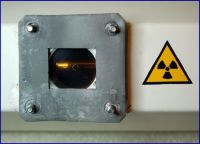

It will be a week or ten days before I can find time to re-assemble Hekla, and provide the 70keV Ohm-per-Gy data needed for others to use this simple direct reading dosimeter.
Proud Mary, Thu Jan 06 2011, 06:50PM
A Minor Hiccough
I've put away my Pull Me - I'm a Little Christmas Cracker! T-shirt till next year, and set about the sober business of providing some calibration base lines for other builders.
I rarely find anything sufficiently interesting >30keV, but I know that I'm more or less alone with these long, soft waves - except at times for Plazmatron - so a higher energy calibration is needed if the measureless majority are to benefit from the contraption.
I fired up Hekla - 70kV/3mA - but no sooner had the heater delay period ended, than the alarm went off, with auto shut-down.
The fault proved to be a mGy sized leak caused by distortion of the lead gasket interface between the tube housing flange and the apex of the beam shielding pyramid, as these pictures make clear.



It will be a week or ten days before I can find time to re-assemble Hekla, and provide the 70keV Ohm-per-Gy data needed for others to use this simple direct reading dosimeter.
Print this page